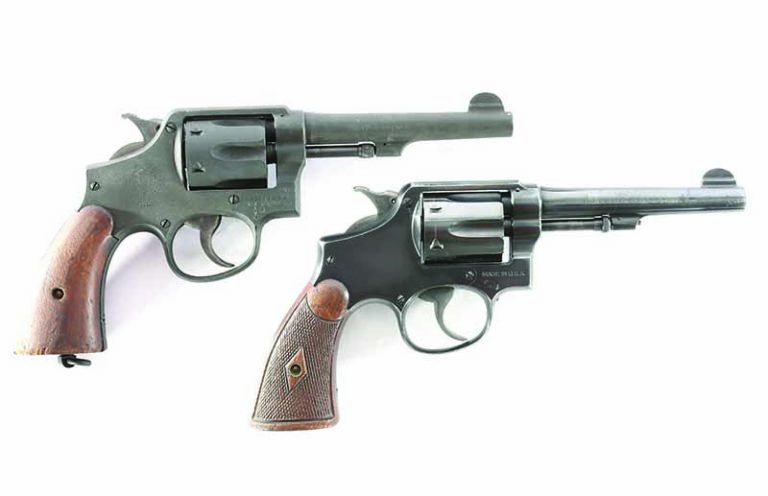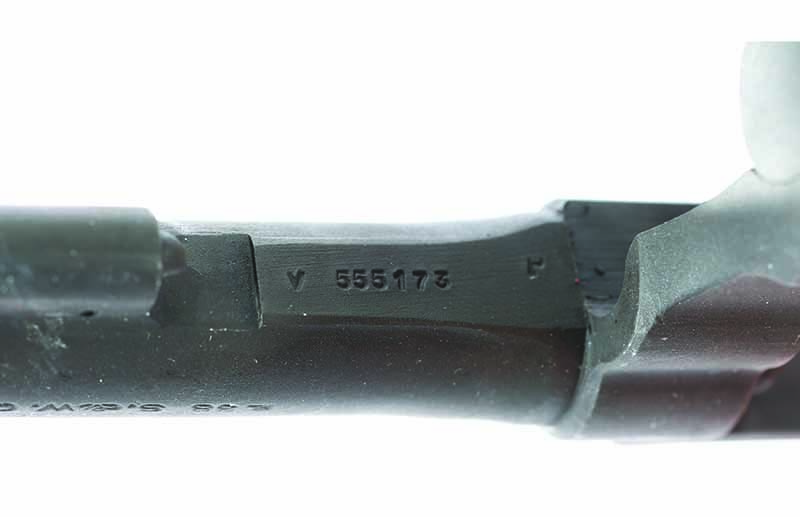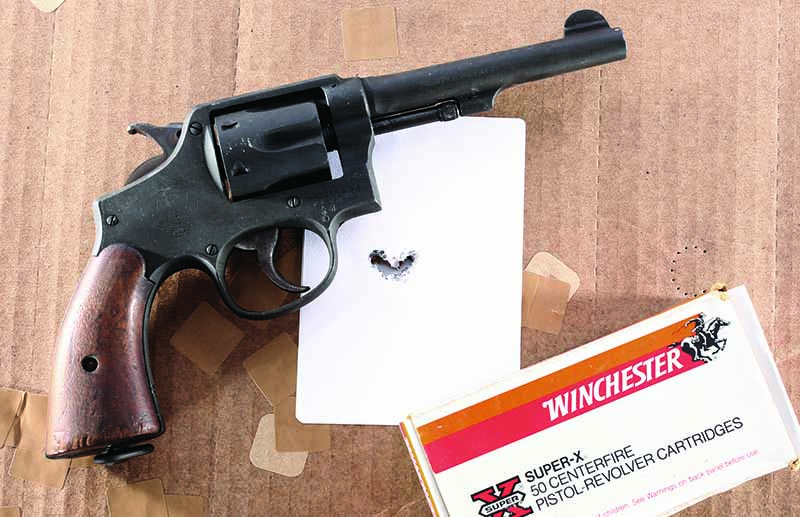
A wartime version of the original Model 10, the Smith & Wesson Victory model is a class WWII collectible.
How To Know It's A S&W Victory Model:
- They have a “V” prefix in the serial number.
- U.S.-purchased guns have “US Government Property” roll-marked on the topstrap.
- As well as the flaming bomb ordnance mark and the inspector’s initials.
- Ones made for Commonwealth often have markings from British services.
- Some will have both U.S. and British markings.
There have always been Luger collectors. They’re the hot, sexy redheads of the handgun world—and good for those who have them. Of course, there are other collectible handguns as well, such as the ones made for Allied use in World War II.
At the start of WWII, we had a problem. Oh, we’d been here before—the one they had called The Great War. We didn’t have enough firearms. (I’m sure the next time we have a big war, we’ll have the exact same problem.) With all the services mobilizing and expanding, we needed guns. Smith & Wesson didn’t drop everything and begin making 1911s, machine guns and artillery pieces. They were set up to make revolvers, and there were plenty of uses for firearms that didn’t necessarily call for something chambered in .45 ACP. And plenty who wanted them.
So, S&W kept making revolvers.
The first production batches shipped to eager military buyers were simply the same M&P revolvers that S&W had been making, in the same high-polish blue, because that’s what they made. But the need for wartime production rates and a more durable finish soon had the revolvers sporting parkerized finishes and plain wooden grips.
Meanwhile, the British had also been busy.
The production of revolvers by S&W for the British was easy. The standard U.S. revolvers were all chambered in .38 Special, also known as .38 S&W Special. The British revolvers of the time, the Enfield, were chambered for the cartridge the British had adopted in the 1920s, the .38-200, known here as the .38 S&W (no Special).

The origins of the .38 S&W date back to 1877, and since that time, the loadings here in the U.S. had been kept mild in deference to the original black powder revolvers and the later top-break “bulldog”-type revolvers. So, the U.S. loading was (and still is) a 146- or 148-grain round-nose lead bullet at a nominal 650 fps. The British adopted the same cartridge case, but loaded it with a 200-grain bullet at 650 fps. They called it the .38-200.
Now, a brief aside here: If you do find any actual, real, .38-200 ammunition, or the later FMJ version of it, do not—under any circumstances—fire it in a clanky old Iver Johnson or other top-break revolver … even a S&W top-break. The original .38 S&W is held to a paltry 13,000 psi, out of deference to the old top-breaks. The Smith & Wesson Victory Model and the Enfields can take full .38 Special pressures, which the .38-200 mostly reaches for. Oh, and it’s all rare collectible ammo, as well.
Striving For Victory
Why “Victory” model? Really? You have to ask? There was a war on. Well, that, and S&W had hit the million-number-mark in serial numbers early in the war, and they had to do something. So, they added a “V” as a prefix and started over, with the Smith & Wesson Victory Model revolvers all being parkerized with smooth wooden grips. The serial number is on the bottom of the frame, with the V sometimes on one side of the lanyard loop, and the serial number on the other. Or not. I’ve seen both. The U.S. Navy had a corpsman die from a dropped revolver discharging, and S&W underwent a crash program to redesign the hammer block. The ones made after the design change have a “VS” as the prefix.
Minding Specifics
OK, now for the details. The U.S.-purchased ones will have “US Government Property” roll-marked on the topstrap, along with the flaming bomb ordnance mark and the inspector’s initials. They’ll have 4-inch barrels, although a small batch were made with 2-inch barrels near the end of the war with the regular square-butt frame. The ones made for Commonwealth purchase had 5-inch barrels; they initially lacked the “US Government Property” markings, and they acquired others when accepted by the various British services. Some will have both U.S. and British markings. These would’ve been the Lend-Lease revolvers provided as loans to the British for the war.

The markings on my Smith & Wesson Victory model tell quite the tale. Marked on the lower right front side of the frame, there’s the D-arrow-D, indicating it was accepted for use by Australia during the war. Below that, there’s the FTR/MA 54. This indicates that it received a through factory inspection or overhaul, in 1954, at the Lithgow Arsenal. (FTR: Thorough Factory Repair.)
Then, there’s the L-arrow-19 marking and another arrow next to it, which is more info. The L-arrow-19 is the inspector’s markings, indicating that it passed its inspection after rebuild, and the arrow next to it is the property mark used by Australia after the war. S&W provided some 571,000 revolvers to the British, but of those, only 8,000 went to Australia, so that makes the non-U.S. marked ones rare. Mine has both markings, so it’s one of the Lend-Lease revolvers.
The FTR on mine probably required a re-parkerizing, because the US Property stamping is rather light, even though mine is in the half-million range of serial numbers. So, in 1954, it got pulled out of whatever depot it was in, inspected, rebuilt, parkerized and sent back into inventory.
The serial numbers on the frame, barrel and cylinder all match, as they should, on any prewar or wartime revolver, also known as the “five-screw” model—so-called because there are four screws holding the sideplate on and another on the front of the frame to tension the cylinder lock bolt spring. On the left side is Vega Sac Ca., which was the importer who brought a bunch of these Australian revolvers into the U.S. back in the 1980s.

It was relatively common back in the 1950s and 1960s to find the Commonwealth Victory Models with reamed chambers. The .38 S&W ammo wasn’t common and less powerful than .38 Special. So, enterprising hacks would pop a .38 Special reamer into the chambers and lengthen them enough to accept .38 Special ammo.
The result was a revolver that was less accurate, but superb at destroying brass. The .38 S&W case is larger in diameter than the Special, in order to accept the .360- to .361-inch diameter bullets. The Special case expands into the larger chamber, at least up to the point where the Special reamer made the cylinder the “proper” diameter. Fired cases in such a revolver are ugly and ruined. But, back in the ’50s and ’60s, few reloaded, and those who had such a Smith & Wesson Victory model didn’t care.
Respect Your Elders
As indicated by the markings, mine was imported by the Vega company, out of Sacramento, California (before the West Coast went completely crazy). It’s still in .38 S&W—which is a good thing, because it’s amazingly accurate. For a revolver that’s now over 75 years old, chambered in a cartridge designed almost a century and a half ago, it’s a tack-driver. One group in particular I have to keep as a bragging group: Five shots, 25 yards, over sandbags, all into a one-hole group.
Now, a 146-grain bullet at a paltry 600 fps isn’t exactly the hammer of Thor. However, it’s a tack-driver, and once I get some Commonwealth-equivalent ammo loaded up, I’ll be stylin’. That one calls for a 200-grain lead round-nosed bullet at something like 650 fps, which still isn’t a magnum, but was deemed good enough for the British. I’ve got bullets coming from Matt’s Bullets of the proper type and dies from RCBS, and once they’re here, we’ll see what a pinch or a pinch and a half of fast-burning powder gets us.

The Luger gets the glory. The 1911 got IPSC. Various .38 Specials won bull’s-eye and PPC matches for decades, and still do. But this Victory model might well have ridden in a holster across the Pacific, dodging kamikazes, assaulting islands, or riding in aircraft. Heck, even if it spent the entire war just guarding supplies, that’s honest service, and that’s enough to make it collectible.
I still haven’t found the answer to why, when they switched from 200-grain lead bullets to FMJ bullets, the British and their allies dropped the weight down to 178 grains. I mean, really? But if I do ever find out, I’ll let you know.

S&W Victory Model Specs:
Action: Double-Action
Caliber: .38 S&W
Capacity: 6 rounds
Barrel: 5 inches
Length: 9.75 inches
Weight: 26 ounces
Trigger: 5 pounds, 2 ounces SA; 12 pounds DA
Finish: Parkerized
The article originally appeared in the March 2021 issue of Gun Digest the Magazine.
Raise Your Smith & Wesson IQ:
- Smith & Wesson Performance Center
- M&P9 Shield EZ
- Model 648
- Model 442
- Model 929
- M&P380 Shield EZ
- M&P10 Sport
- Model 629
- SW22 Victory
- M&P45 Shield
- Model 629 Performance Center
- M&P15
- M&P R8
- Schofield
- Smith & Wesson .357 Magnum Revolver
- Triple-Lock

Next Step: Get your FREE Printable Target Pack
Enhance your shooting precision with our 62 MOA Targets, perfect for rifles and handguns. Crafted in collaboration with Storm Tactical for accuracy and versatility.
Subscribe to the Gun Digest email newsletter and get your downloadable target pack sent straight to your inbox. Stay updated with the latest firearms info in the industry.

![Best Concealed Carry Guns In 2025 [Field Tested] Wilson Combat EDC X9S 1](https://gundigest.com/wp-content/uploads/Wilson-Combat-EDC-X9S-1-324x160.jpg)


![Best 9mm Carbine: Affordable PCCs [Tested] Ruger Carbine Shooting](https://gundigest.com/wp-content/uploads/Ruger-Carbine-Shooting-100x70.jpg)
![Best AR-15: Top Options Available Today [Field Tested] Harrington and Richardson PSA XM177E2 feature](https://gundigest.com/wp-content/uploads/Harrington-and-Richardson-PSA-XM177E2-feature-100x70.jpg)

the200 gr was determined by the Hague Convention rules to be inhumane as it tumbles upon striking target. the Brits dertermined it was equal to striking power to the .455 webley but lighter bullets
The initial British load was indeed a lead 200 grain bullet, but it was very soon replaced with a jacketed 174 grain bullet to comply with the Hague convention. I don’t know why they used a lighter bullet. Due to shortages, both were used during WWII.
You state, ” the later top-break “bulldog”-type revolvers. ” Bulldogs are solid frame. Perhaps you meant, “the later top-break AND “bulldog”-type revolvers. ” ?
Given pressure differences between cast and jacketed the 174 grainer may have just been the maximum jacketed bullet that would have the same max pressure as the 200 grainer. Above the reason was lead bullets are expanding and thus inhumane, not that they tumbled. Many claim the 174s tumble on impact. Who knows
Shooting both 200g LRN and 178g FMJ bullets into water jugs from a variety of .38 S&W revolvers with barrel lengths of 2″, 4″, and 5″, I observed both bullets to tumble quite reliably. The FMJ ammo tumbled a bit more violently, displaying a greater tendency to burst jugs instead of simply punching or ripping a hole through them.
Velocities on the vintage factory loads ran 570-650 fps, depending on the gun and ammo used, and reliably penetrated 5 or 6 water-filled 6-inch-wide milk jugs. Snubbies usually penetrated 5 jugs; 4″-5″ barrels reliably penetrated 6 jugs, with the bullets always curving to the left and down. (I used S&W revolvers with RH twist rifling, which perhaps accounts for the leftward movement.) Sometimes, tumbling was so severe that the bullets exited out the left side of #3 or #4, especially if I didn’t center-punch #1.
Faster 200g handloads (about 675 fps or higher) OR use of flat-nosed bullets, however, always stabilized the projectile enough to drive through 6 jugs in a straight line.
I flew as head spook on EC-121M reconnaissance aircraft in the early-mid 1970s. As the senior guy I carried an S&W Victory .38 special and extra ammo on each flight. BTW, it was the only armament on the aircraft!